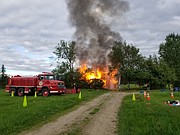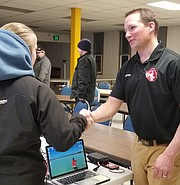Cancer: A silent killer of firefighters
BONNERS FERRY — They answer a calling, donning equipment and charging in when others run away. They face fire, accidents, and emergencies. They are our firefighters.
The firefighters put their life on the line on a daily basis, but it is a silent killer that may be threatening them the most — cancer.
According to numerous scientific studies and data collected and evaluated by the National Institute for Occupational Safety and Health (NIOSH) and by the International Association of Fire Fighters (IAFF) Line of Duty Deaths Database, cancer is the second leading cause of deaths among firefighters today. More than 60 percent of Line of Duty Deaths (LODD) are due to cancer.
Because firefighters work in an uncontrolled atmosphere compared to most other occupations, the exact studies are more difficult, but known and probable carcinogens include benzene and formaldehyde. Houses and other building structures today contain much more plastics and other harmful substances than in the past. Another silent killer is the exposure to diesel fumes from the engines, especially in closed in spaces.
To address this concern, the Boundary County Fire Chiefs Association brought in Big Sky Fire Department Battalion Chief Training Officer Seth Barker on Thursday, Feb. 28.
South Boundary Fire Chief Tony Rohrwasser had listened to Barker talk at a conference he attended in Missoula. Since they were approaching a time to replace their turnouts, Rohrwasser suggested bringing this education to our county.
More than 60 firefighters and first responders turned out for the class upstairs in the Bonners Ferry City Fire Department from 8 to 10 p.m., after enjoying a meal provided by Helping Hands of Naples.
Barker engaged his audience, sharing personal stories about his own battle with cancer, statistics, and safety methods.
An important subject that was discussed, was the stopping the spread of toxins into vehicles, fire departments, and even into the firefighter’s own homes. Barker showed a video that followed traceable dust, in a disturbing manner, leading from the scene to firefighter’s homes, their families and children.
Among all the safety precautions was an important shift in culture that Barker spoke about. Gone our the days of the “salty ole dog” look — a firefighter with soot covering his face. That soot carries carcinogens that can be transferred directly to the firefighter through the skin and can even be ingested. Wearing protective gear and masks at all times while on the fire was stressed throughout the presentation.
“I am the old dog that they talk about, hard to teach me new tricks,” said South Boundary Assistant Fire Chief Wayne Wilkerson. “Everything he was talking about — you hear about it — but he put it into ‘life’ for us, because he has dealt with it. This is good stuff. It is going to be hard to implement, but I think we are going to have to go there … we should go there.”
On the other end of the spectrum was young Hall Mountain Firefighter Ben Allinger, who came away from the class with a new perspective on how he was going to handle his turnout gear.
“We don’t really have a choice, we have to carry them in out vehicles, so trying to find a better way to store them,” said Allinger.
He also had a new awareness of the importance of the general cleanliness of their engines.
“We are already talking about some other ideas that we would like to do, but whether that is feasible to do financially, I don’t know,” said Allinger.
For Rohrwasser, he felt like the class was a success.
“I lot of people who were not aware were asking questions, so I think it opened up a few people’s eyes, because unless you are getting out and into some of these bigger areas, conferences and things like that, there is no way of really getting information, unless you are diligent about trying to find it one the internet,” said Rohrwasser. “Who’s going to start looking for cancer and things like that?”
North Bench Firefighter Tom Chaney said, “I think it is great. There is a lot that we probably can’t do with a limited budget — not everybody has two sets of turnouts — but there are simple things that they can do, like making sure you clean.”
Gus Jackson, President of the Boundary County Fire Chiefs Association and Chief of North Bench Fire, thought the presentation was “fantastic.”
“I look forward to the Chief’s Association bringing in somebody like this every year,” said Jackson.
For Barker, who has been teaching this class for two and a half years, his main focus is to stop fellow firefighters from having to endure the experience that he did, in battling cancer.
“It positively affect the culture and hopefully it makes a change to make sure that everybody is going home,” said Barker. “If we can just have one person bring one nugget home, that is going to make their organization, their health, or their lifestyle change — that is a win for us.”
More information: bigskyfiretraining.com









